Shenghan Su
Perception-Inspired Color Space Design for Photo White Balance Editing
Dec 11, 2025Abstract:White balance (WB) is a key step in the image signal processor (ISP) pipeline that mitigates color casts caused by varying illumination and restores the scene's true colors. Currently, sRGB-based WB editing for post-ISP WB correction is widely used to address color constancy failures in the ISP pipeline when the original camera RAW is unavailable. However, additive color models (e.g., sRGB) are inherently limited by fixed nonlinear transformations and entangled color channels, which often impede their generalization to complex lighting conditions. To address these challenges, we propose a novel framework for WB correction that leverages a perception-inspired Learnable HSI (LHSI) color space. Built upon a cylindrical color model that naturally separates luminance from chromatic components, our framework further introduces dedicated parameters to enhance this disentanglement and learnable mapping to adaptively refine the flexibility. Moreover, a new Mamba-based network is introduced, which is tailored to the characteristics of the proposed LHSI color space. Experimental results on benchmark datasets demonstrate the superiority of our method, highlighting the potential of perception-inspired color space design in computational photography. The source code is available at https://github.com/YangCheng58/WB_Color_Space.
Emergence of Painting Ability via Recognition-Driven Evolution
Jan 09, 2025Abstract:From Paleolithic cave paintings to Impressionism, human painting has evolved to depict increasingly complex and detailed scenes, conveying more nuanced messages. This paper attempts to emerge this artistic capability by simulating the evolutionary pressures that enhance visual communication efficiency. Specifically, we present a model with a stroke branch and a palette branch that together simulate human-like painting. The palette branch learns a limited colour palette, while the stroke branch parameterises each stroke using B\'ezier curves to render an image, subsequently evaluated by a high-level recognition module. We quantify the efficiency of visual communication by measuring the recognition accuracy achieved with machine vision. The model then optimises the control points and colour choices for each stroke to maximise recognition accuracy with minimal strokes and colours. Experimental results show that our model achieves superior performance in high-level recognition tasks, delivering artistic expression and aesthetic appeal, especially in abstract sketches. Additionally, our approach shows promise as an efficient bit-level image compression technique, outperforming traditional methods.
Paleoinspired Vision: From Exploring Colour Vision Evolution to Inspiring Camera Design
Dec 27, 2024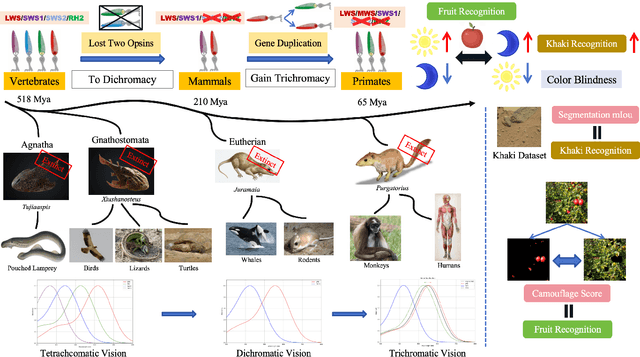
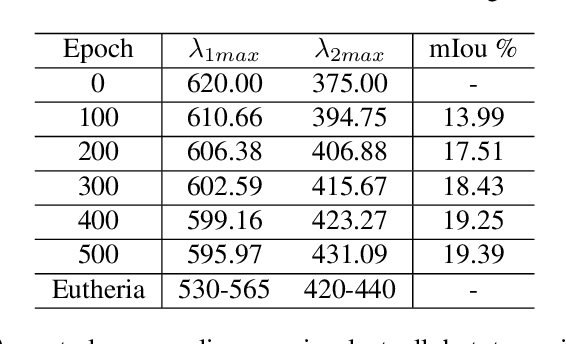
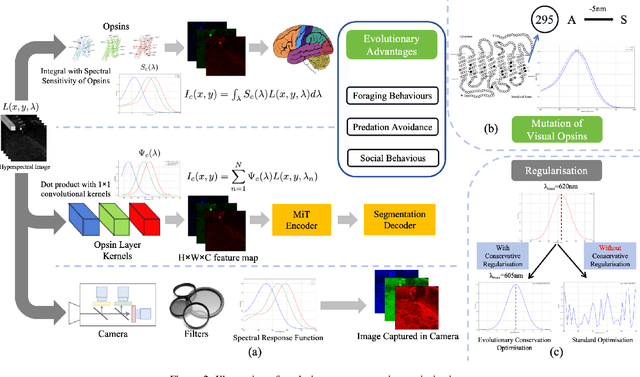

Abstract:The evolution of colour vision is captivating, as it reveals the adaptive strategies of extinct species while simultaneously inspiring innovations in modern imaging technology. In this study, we present a simplified model of visual transduction in the retina, introducing a novel opsin layer. We quantify evolutionary pressures by measuring machine vision recognition accuracy on colour images shaped by specific opsins. Building on this, we develop an evolutionary conservation optimisation algorithm to reconstruct the spectral sensitivity of opsins, enabling mutation-driven adaptations to to more effectively spot fruits or predators. This model condenses millions of years of evolution within seconds on GPU, providing an experimental framework to test long-standing hypotheses in evolutionary biology , such as vision of early mammals, primate trichromacy from gene duplication, retention of colour blindness, blue-shift of fish rod and multiple rod opsins with bioluminescence. Moreover, the model enables speculative explorations of hypothetical species, such as organisms with eyes adapted to the conditions on Mars. Our findings suggest a minimalist yet effective approach to task-specific camera filter design, optimising the spectral response function to meet application-driven demands. The code will be made publicly available upon acceptance.
Name Your Colour For the Task: Artificially Discover Colour Naming via Colour Quantisation Transformer
Dec 07, 2022Abstract:The long-standing theory that a colour-naming system evolves under the dual pressure of efficient communication and perceptual mechanism is supported by more and more linguistic studies including the analysis of four decades' diachronic data from the Nafaanra language. This inspires us to explore whether artificial intelligence could evolve and discover a similar colour-naming system via optimising the communication efficiency represented by high-level recognition performance. Here, we propose a novel colour quantisation transformer, CQFormer, that quantises colour space while maintaining the accuracy of machine recognition on the quantised images. Given an RGB image, Annotation Branch maps it into an index map before generating the quantised image with a colour palette, meanwhile the Palette Branch utilises a key-point detection way to find proper colours in palette among whole colour space. By interacting with colour annotation, CQFormer is able to balance both the machine vision accuracy and colour perceptual structure such as distinct and stable colour distribution for discovered colour system. Very interestingly, we even observe the consistent evolution pattern between our artificial colour system and basic colour terms across human languages. Besides, our colour quantisation method also offers an efficient quantisation method that effectively compresses the image storage while maintaining a high performance in high-level recognition tasks such as classification and detection. Extensive experiments demonstrate the superior performance of our method with extremely low bit-rate colours. We will release the source code soon.
Illumination Adaptive Transformer
May 30, 2022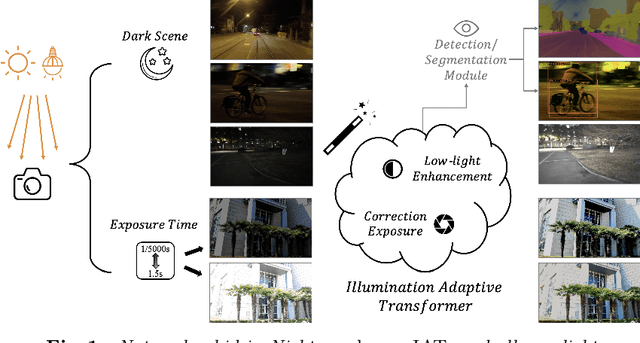
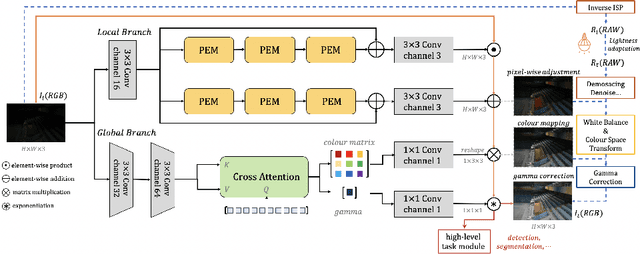
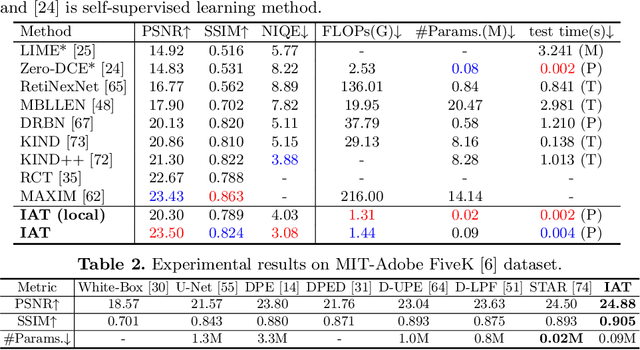

Abstract:Challenging illumination conditions (low light, underexposure and overexposure) in the real world not only cast an unpleasant visual appearance but also taint the computer vision tasks. Existing light adaptive methods often deal with each condition individually. What is more, most of them often operate on a RAW image or over-simplify the camera image signal processing (ISP) pipeline. By decomposing the light transformation pipeline into local and global ISP components, we propose a lightweight fast Illumination Adaptive Transformer (IAT) which comprises two transformer-style branches: local estimation branch and global ISP branch. While the local branch estimates the pixel-wise local components relevant to illumination, the global branch defines learnable quires that attend the whole image to decode the parameters. Our IAT could also conduct both object detection and semantic segmentation under various light conditions. We have extensively evaluated IAT on multiple real-world datasets on 2 low-level tasks and 3 high-level tasks. With only 90k parameters and 0.004s processing speed (excluding high-level module), our IAT has consistently achieved superior performance over SOTA. Code is available at https://github.com/cuiziteng/IlluminationAdaptive-Transformer.
Explainable Analysis of Deep Learning Methods for SAR Image Classification
Apr 14, 2022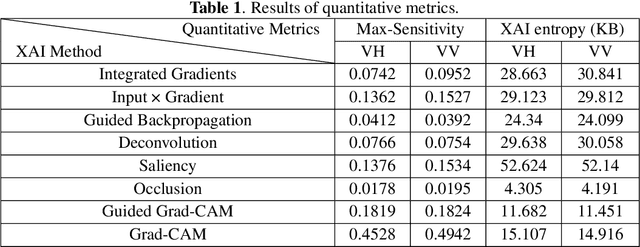
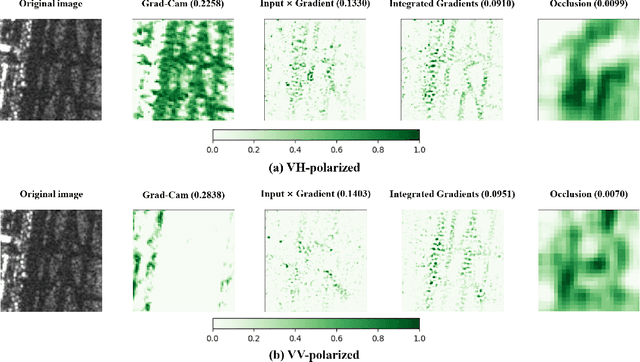
Abstract:Deep learning methods exhibit outstanding performance in synthetic aperture radar (SAR) image interpretation tasks. However, these are black box models that limit the comprehension of their predictions. Therefore, to meet this challenge, we have utilized explainable artificial intelligence (XAI) methods for the SAR image classification task. Specifically, we trained state-of-the-art convolutional neural networks for each polarization format on OpenSARUrban dataset and then investigate eight explanation methods to analyze the predictions of the CNN classifiers of SAR images. These XAI methods are also evaluated qualitatively and quantitatively which shows that Occlusion achieves the most reliable interpretation performance in terms of Max-Sensitivity but with a low-resolution explanation heatmap. The explanation results provide some insights into the internal mechanism of black-box decisions for SAR image classification.
 Add to Chrome
Add to Chrome Add to Firefox
Add to Firefox Add to Edge
Add to Edge